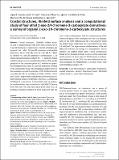Files in this item
Crystal structures, Hirshfeld surface analysis and a computational study of four ethyl 2-oxo-2H-chromene-3-carboxylate derivatives : a survey of organyl 2-oxo-2H-chromene-3-carboxylate structures
Item metadata
| dc.contributor.author | Gomes, Ligia R. | |
| dc.contributor.author | Low, John N. | |
| dc.contributor.author | van Mourik, Tanja | |
| dc.contributor.author | da Silveira Pinto, Ligia S. | |
| dc.contributor.author | de Souza, Marcus V. N. | |
| dc.contributor.author | Wardell, Jámes L. | |
| dc.date.accessioned | 2020-01-24T00:35:11Z | |
| dc.date.available | 2020-01-24T00:35:11Z | |
| dc.date.issued | 2019-02-25 | |
| dc.identifier | 255876916 | |
| dc.identifier | 872e2570-796f-401d-8004-66301e5da453 | |
| dc.identifier | 85060692188 | |
| dc.identifier | 000457390700002 | |
| dc.identifier.citation | Gomes , L R , Low , J N , van Mourik , T , da Silveira Pinto , L S , de Souza , M V N & Wardell , J L 2019 , ' Crystal structures, Hirshfeld surface analysis and a computational study of four ethyl 2-oxo-2H-chromene-3-carboxylate derivatives : a survey of organyl 2-oxo-2 H -chromene-3-carboxylate structures ' , Zeitschrift fur Kristallographie , vol. 234 , no. 2 , pp. 85-99 . https://doi.org/10.1515/zkri-2018-2117 | en |
| dc.identifier.issn | 0044-2968 | |
| dc.identifier.other | ORCID: /0000-0001-7683-3293/work/57088445 | |
| dc.identifier.uri | https://hdl.handle.net/10023/19345 | |
| dc.description | LRG thanks the Portuguese Foundation for Science and Technology (FCT) UID/Multi/04546/2013.for support. TvM is grateful to EaStCHEM for computational support via the EaStCHEM Research Computing Facility. JLW thanks CNPq, Brazil for support. | en |
| dc.description.abstract | Crystal structures, Hirshfeld surface analysis and a computational study have been carried out on 2-oxo-2H-chromene-3-carboxylates. Crystal structures are reported for ethyl R-2-oxo-2H-chromene-3-carboxylate derivatives, 2a: R=6-Me, 2b: 7-Me, 2c: 7-Me, 2d: R=7-MeO. In contrast to 2-oxo-2H-chromene-3-carboxamides, 1, in which classical intramolecular N–H···O hydrogen bonds stabilize planar structures and hinder rotation of the amido group out of the coumarin plane in 2, without an equivalent hydrogen bond, there is a greater rotational freedom of the carboxylate group. The interplanar angles between the coumarin core and its attached –C(O)–R substituent in crystalline 2a, 2b, 2c and 2d are 10.41(6), 36.65(6), 10.4(2) and 5.64(6)°, respectively, with distances between the carbonyl oxygen atoms of 2.8255(16), 2.9278(16), 4.226(2) and 2.8328(14) Å, respectively. A theoretical study of molecular conformations was carried out at the M06-2X density level with the 6-31+G(d) and aug-cc-pVTZ basis sets, in methanol solution modeled by PCM, indicated that the most stable conformations had the carbonyl group of the ester in the plane of the coumarin core: the s-cis arrangement of the ester carbonyl and the 2-oxo moieties being the slightly more stable than the s-trans form by less than 0.5 kcal/mol. The experimental conformations of 2a and 2d match well the low energy s-cis arrangement, and 2c matches the slightly lesser stable s-trans arrangement found in the theoretical study. A survey of the molecular conformations of more than 50 2H-chromene-3-carboxylates derivatives in the CCDC data base indicated two distinct groupings of conformations, s-cis and s-trans, each with interplanar angles <30°. | |
| dc.format.extent | 16 | |
| dc.format.extent | 5490123 | |
| dc.language.iso | eng | |
| dc.relation.ispartof | Zeitschrift fur Kristallographie | en |
| dc.subject | 2-oxo-2H-chromene-3-carboxylate derivatives | en |
| dc.subject | Crystal structures | en |
| dc.subject | Density functional theory | en |
| dc.subject | Hirshfeld surface analysis | en |
| dc.subject | Molecular conformation | en |
| dc.subject | QD Chemistry | en |
| dc.subject | DAS | en |
| dc.subject.lcc | QD | en |
| dc.title | Crystal structures, Hirshfeld surface analysis and a computational study of four ethyl 2-oxo-2H-chromene-3-carboxylate derivatives : a survey of organyl 2-oxo-2H-chromene-3-carboxylate structures | en |
| dc.type | Journal article | en |
| dc.contributor.institution | University of St Andrews. EaSTCHEM | en |
| dc.contributor.institution | University of St Andrews. School of Chemistry | en |
| dc.identifier.doi | https://doi.org/10.1515/zkri-2018-2117 | |
| dc.description.status | Peer reviewed | en |
| dc.date.embargoedUntil | 2020-01-24 |
This item appears in the following Collection(s)
Items in the St Andrews Research Repository are protected by copyright, with all rights reserved, unless otherwise indicated.

